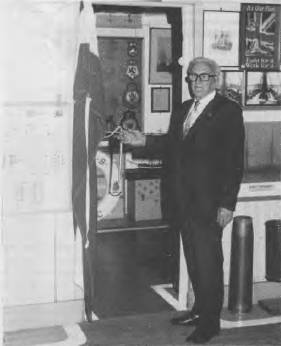- Author
- Lind, L.J.
- Subjects
- History - general
- Tags
-
- RAN Ships
- None noted.
- Publication
- December 1990 edition of the Naval Historical Review (all rights reserved)
Old Sydney Town
Returning to the Society, in 1973 an approach had been made to us by Fox and Associates, Architects for advice and assistance on their historical project on the Central Coast, Old Sydney Town. The Committee considered this a worthy cause and one that involved the Navy in the first settlement of Australia. Later in the year we changed our venue to the offices and display centre of Old Sydney Town in the Rocks area of Sydney.
The new venue had atmosphere, comfort and interest to all members. Many of the displays for Old Sydney Town were taking shape at the location and the company assisted the Society in every way. A number of members joined the undertaking on the site and contributed a lot to the success of the undertaking.
We enjoyed many interesting speakers at the venue and one many will still remember is ‘The Navy Career of Captain Joseph Burnett, RAN’ which was presented by his son, Commander P.R. Burnett, RAN (Ret.). The lecture was later published in the Naval Historical Review.
1974
The Committee elected in 1974 consisted of Mr L.J. Lind, President; Lieutenant R. Torrington and Mr M.A. Payne, Vice Presidents; Lieutenant Commander P. Churchill, Secretary; Miss B. Whiting, Treasurer; Captain W. Cook, Lieutenant R. Atwill, and Messrs R. Scrivener, A. McEwen, A. Birch and S. Hertz, Committee.
Our fourth Chapter, Australian Capital Territory, was formed during the year. With its large naval population ACT was to remain a strong Chapter.
It is interesting to note that the Committee had decided to dispense with Vice Patrons and the list of Patrons was increased accordingly. They were: Admiral Sir Victor Smith, KBE, CB, DSC; Vice Admiral Sir Henry Burrell, KBE, CB; Vice Admiral Sir Richard Peek, KBE, CB, DSC; Vice Admiral H.D. Stevenson, CBE; Rear Admiral G.J.B. Crabb, CBE, DSC; Rear Admiral B.W. Mussared, CBE; Rear Admiral W.D.H. Graham, CBE; Rear Admiral D.C. Wells, CBE; Rear Admiral W. Dovers, CBE, DSC; and Mr Samuel Landau, CBE, MA.
Garden Island Museum Collection and more publishing

The Society’s first exhibition was held on Navy Day at Garden Island. It was staged in the Sail Loft in conjunction with displays by the sailmakers and flagmakers. At this period our collection was small but it was supplemented with items from the Dockyard collection. This was our first exposure to the public and during the day some thousands of people passed through. Those who assisted on the display agreed it was a success. We sold quite a number of our publications and handed out several hundred membership applications.

From the time of my appointment to Garden Island in 1966 I was conscious of the need of a historical collection. It started initially with the collection of antique cannon and two ships’ figureheads which had been presented to the dockyard in the distant past. To these I added over the years any item I considered to be historically important. Then, as now, storage space was at a premium, but a small caged area in the tunnels under the northern hill was allocated. The first item I stowed there was a cane coaling basket which today is on display in the Garden Island Museum. Since then hundreds of items have been salvaged from the dockyard or ships paying off and not a few from public donors.
With the advent of the Society a second historical collection was initiated and these two collections were merged to make the Garden Island Museum Collection.
Our first meeting at Snapper Island was held in 1974 and a close association developed between Commander Len Forsythe and the Society. In later years the Society maintained a gallery in the Snapper Island Museum.
Alan Payne
The second book published in this year was ‘HMAS AUSTRALIA’ which was written by Alan Payne. We were very fortunate in having a close relationship with the Navy Historian, Mr J. Ware at Navy Office, who through the years provided copies of ships’ Letters of Proceedings and other information without which the task of compilation would have been impossible. Another important information source was the many diaries kept by the ships crews and kindly lent to the Society. (Whatever happened to that regulation forbidding the keeping of personal diaries in time of war?)




